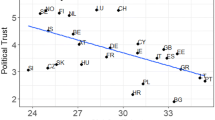Abstract
The question of whether a citizen is obliged to obey the law has occupied scholarly thinking since the days of Socrates. Thus, rarely has the question been examined empirically. Based on a survey of 1866 adults, citizens of the state of Israel, this study attempts to construct causal models linking socioeconomic status to subjective measures of injustice, and further to indicators of illegalism and disobedience among Jews and Arabs. LISREL analysis has been found a useful tool to construct the empirical models that measure how members of the two ethnic communities relate to the boundaries of the “prima facie obligation” to obey the law. Findings show that those who have no trust in one part of the legal system, will also have no trust in the rest of the system which, in turn, serves to legitimize taking the law into one's own hand.
Similar content being viewed by others
REFERENCES
Barzilai, G., Yuchtman-Yaar, E., and Segal, Z. (1994). The Israeli Supreme Court and the Israeli Public. Papirus, Tel-Aviv University Press (in Hebrew).
Ben-Nun, C. (1992). Civil Disobedience, Yaar Publishers, Yaar (in Hebrew).
Biafora, F. A., Warheit, G. J., Zimmerman, R. S., Gil, A. G., Apospori, E. A., Vega, W. A., and Taylor, D. L. (1993). Cultural mistrust and deviant behaviors among ethnically diverse black adolescent boys. J. Appl. Soc. Psychol. 23: 891-910.
Georges-Abeyie, D. (1984). The Criminal Justice System and Blacks, Clark Boardman, New York.
Hagan, J., and Albonetti, C. (1982). Race, class, and the perception of criminal injustice in America. Am. J. Sociol. 88(2): 239-355.
Herr, W. A. (1974). Thoreau: A civil disobedient? Ethics 85: 87-91.
Huggins, M. (1985). Approaches to crime and societal developments. Comp. Soc. Res. 8: 17-35.
Joreskog, K. G., and Sorbom, D. (1988). Prelis: A Program for Multivariate Data Screening and Data Summarization. A Preprocessor for LISREL, SSI, Chicago.
Joreskog, K. G., and Sorbom, D. (1993). LISREL8: A Guide to the Program and Applications, SPSS, Chicago.
Kahneman, I., and Zemach, T. (1991). The Image of the Israel Police in the Eyes of the Public and Public Attitudes Toward the Police on Selected Topics. Louis Guttman Institute of Applied Social Research, Publication No. IK/1100/H, Jerusalem.
Kretzmer, D. (1990). The Legal Status of Arabs in Israel, Westview Press, Boulder, CO.
Locke, J. (1960). In Laslett, P. (ed.), Two Treatises of Government, Cambridge University Press, Cambridge.
Negbi, M. (1987). Above the Law: The Constitutional Crisis in Israel, Am Oved (in Hebrew).
Peretz, D. (1988). Israelis, Palestinians, and multinationalism. J. Int. Affairs 27(1).
Plato (1959). The Last Days of Socrates, Tredennick, H. (trans.), Penguin Books, Harmondsworth.
Quinn, R. P., Gutek, B. A., and Walsh, J. T. (1980). Telephone interviewing: A reappraisal and a field experiment. Basic Appl. Soc. Psychol. 1: 127-154.
Rattner, A. (1994). The margins of justice attitudes towards the law and the legal system among Jews and Arabs in Israel. Int. J. Public Opin. Res. 6(4): 358-370.
Rattner, A., and Fishman, G. (1998). Justice for All? Jews and Arabs in the Israeli Criminal Justice System, Preger Publishers.
Rawls, J. (1971). A Theory of Justice, Belknap Press of Harvard, Cambridge, MA.
Raz, J. (1975). Practical Reason and Norms, Hutchinson, London.
Rogers, T. F. (1976). Interviews by telephone and in person: Quality of responses and field performance. Public Opin. Q. 40: 51-65.
Sheleff, L. (1989). The Voice of Honor: Civic Disobedience and Civic Loyalty, Ramot Publishing, Tel-Aviv (in Hebrew).
Sprinzak, E. (1986). Every Man Is Right in His Own Eyes: Illegalism In Israeli Society, Sifriat Poalim (in Hebrew).
Sprinzak, E. (1991). The Ascendance of Israel's Radical Right, Oxford University Press, Oxford.
Taylor, L. D., Biafora, F. A., Jr., and Warheit, G. (1994). Racial mistrust among immigrants. Soc. Problems 85: 1923-1939.
Terrell, F. (1980). The development of an inventory to measure certain aspects of cultural mistrust among Blacks. Paper presented at the 5th Conference on Empirical Research in Black Psychology, Howard University, Washington, DC.
Terrell, F., Terrell, S., and Taylor, J. (1981). Effects of race and examiner and cultural mistrust on the WAIS performance of black students. J. Consult. Clin. Psychol. 49: 750-751.
Tyler, T. (1990). Why People Obey the Law, Yale University Press, New Haven, CT, and London.
Weisburd, D. (1989). Jewish Settler Violence: Deviance as Social Reaction, Pennsylvania State University Press, University Park.
Author information
Authors and Affiliations
Rights and permissions
About this article
Cite this article
Rattner, A. Structural Models of Injustice and Illegalism in Israel. Journal of Quantitative Criminology 14, 379–396 (1998). https://doi.org/10.1023/A:1023029821384
Issue Date:
DOI: https://doi.org/10.1023/A:1023029821384




